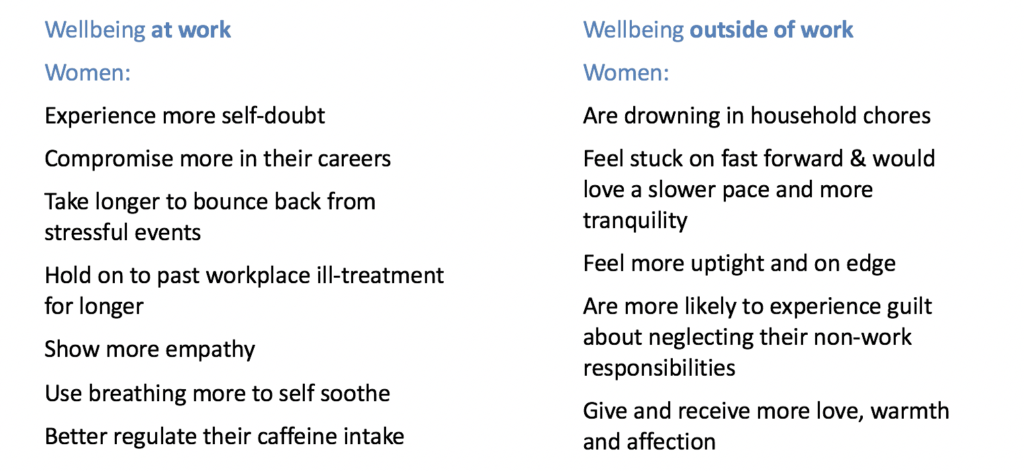What are we learning about gender differences in leaders’ wellbeing?
This week, we’re sharing some of our research findings and considering the implications for leaders and those designing workplace programs.
We’ve been working with the GLWS in organisations for 4 years – which gives us an ever-increasing data set to examine and look for themes.
One topic of interest to us, to Diversity & Inclusion specialists and (we hope) to leaders generally is:
How do male and female leaders rate their wellbeing? Are there any significant differences between the genders? How can this information be useful?
To start off, make your own predictions. What differences, if any, do you think we found between how males and females rated the following:
“I have made compromises in my career because of factors in my personal life.”
“I doubt myself more than I probably should at work.”
“I feel I am drowning in household chores or personal/family administration.”
Now keep your predictions in mind as we build the story around our findings.
The significant differences in how male and female leaders rate their wellbeing
(And the equally valuable findings of similarity!)
We examined this at three levels:
- ‘Overall’ wellbeing differences
In our sample of over 1000 leaders (I’ll explain exactly who’s in the sample at the bottom of this article) the first finding of interest was that:
a. Male leaders reported significantly higher wellbeing outside of work than female leaders and higher wellbeing overall. Or, to put it another way, females leaders reported experiencing lower wellbeing overall compared to their male counterparts and this was echoed in a lower rating for their wellbeing outside of work.
b. There were no significant differences in ratings of wellbeing at work, life satisfactionor happiness.
On the face of it, it seems that female leaders are experiencing something outside of work that detracts from their wellbeing and this subjectively influences how they rate their overall wellbeing.
Whatever this detractor is, it doesn’t seem to be affecting females’ assessments of their life satisfaction or happiness overall. And importantly, the experience of wellbeing in work seems broadly similar (at this high level of interpretation).
- Wellbeing domain differences
When we dug a little deeper into the data and examined how male and female leaders rate the six domains of wellbeing in the GLWS, a few interesting trends start to emerge:
a. Authentic Relationships: no significant differences between males and females on how they rate the quality of their relationships either at work or outside of work.
b. Meaning, Purpose & Direction: no significant differences in either context.
c. Resilience & Equanimity: males rate this significantly higher in both the work and personal contexts.
d. Vitality & Energy: females rate their Vitality & Energy at work higher than males, but broadly the same for outside of work.
e. Balance & Boundaries: No differences at work, but outside of work, females are experiencing significantly lower wellbeing than males.
f. Intellectual Engagement & Flow: no significant differences.
In the first set of findings, females rated their wellbeing outside of work lower. Could it be linked to their levels of Resilience & Equanimity and Balance & Boundaries in their home and personal lives?
Perhaps females find it harder to switch off from work, juggle the demands placed on them at home and make time for themselves? Maybe they experience more difficult emotions and find it harder to maintain emotional steadiness at home?
At work and home, female leaders have rated their emotional wellbeing lower than their male counterparts. We could debate whether this might be because of greater awareness of emotional experience, a real difference in emotional experience, or a higher willingness to share and reveal insights into their emotional experience.
We’ll explore this further, but at this point it’s important to emphasisethat there are more similarities between the ratings of male and female leaders than there are differences. Their relationships, their sense of meaning & purpose and intellectual engagement are being experienced and/or rated in broadly similar ways.
- Wellbeing question differences
There are many questions that show a slight (significant) difference between male and female leaders, but for brevity’s sake we’ll focus on the most significant findings. If you want to see the full results, please contact us.
In summary:
So if you guessed that females would rate higher on all three of the questions I mentioned at the start… you are right!
This level of analysis adds some insights as to why females have a lower rating for Resilience & Equanimity (as above) and Balance & Boundaries at home.
It would seem from our data that equality in the division of labour in the home is yet to be achieved for many couples – females report that they are drowning in household chores to a far greater extent than the males in our sample. They also feel ‘stuck on fast forward’, more uptight and have more guilt (about not devoting more attention to their children and others).
At work, females are still questioning themselves and experience more self-doubt than males. They find it harder to ‘let go’ of past injustices and take longer to bounce back – components of resilience that male leaders are reporting at a higher level.
On the positive side, females are also expressing more empathy for work colleagues and love, warmth and affection in their personal relationships.
So what?
That’s quite a lot of data and we’ve run through it quickly. We acknowledge that gender differences in wellbeing is a very complex area and that we run the risk of over-simplifying.
So, without drawing very bold conclusions, what can we extract from this in terms of useful take-aways?
Here are our top suggestions:
- The data shared above is reported at a group level using mean scores and it’s important to remember that at the individual level, there will be huge variation – in other words, not allfemale leaders will show more empathy than males and so on. Be careful of over-generalising and always take an individual approach to exploring and enhancing wellbeing.
- If you are in a D&I role, the finding that females report lower overall wellbeing than males is an important one – this speaks to the need to ensure that there is a strong wellbeing focus in any and all female leadership programs and in executive coaching for female leaders. This focus has to include wellbeing outside of work, where greater differences are reported between males and females.
One great example of this is how Australia Post implemented a wellbeing focus in their mentoring program for female leaders – read more here.
- This same finding could also be used to help build a case for a wellbeing program for female leaders. An important element in the content of any program should be on building Resilience & Equanimity and Balance & Boundaries, and providing tools and coaching for female leaders to address these challenges in and outside of work.
- If you aren’t already doing this, consider how you support female leaders returning to work after maternity leave. New working parents face particular challenges as they try to develop a ‘new normal’ after a period of significant change. Rob Bravo from Talking Talent describes the importance of supporting this key group of leaders:
“Very often for a returning ‘maternity leaver’ there are consistent themes arising in relation to their wellbeing. Balance and Boundaries is always a big one as they need to work out how to navigate work /life integration in this new world. Their sources of Meaning & Purpose can feel quite different and potentially conflicting. Vitality & Energy can suffer unless they figure out how to manage their own personal energy resources while being pulled in a hundred different directions by work and home life. Our ‘typical’ client is contending with a lot of stuff to juggle when they come back into the workplace and it’s an ideal time to provide support through coaching”.
- The leaders of female leaders should do their part to address the wellbeing challenges highlighted in the data. This could include:
a. Recognising self-doubt and supporting their female leaders to minimise this if it’s holding them back from achieving goals or causing ongoing difficult emotions. Refer to our earlier article on why self-doubt isn’t so bad (and share it if it’s helpful).
b. Identifying what aspects of your own leadership behaviour might be impacting your team’s self- doubt – for example, giving regular and balanced feedback, showing appreciation for good work effort, celebrating success, ensuring people are kept informed, being clear about roles, responsibilities and expectations, sticking to commitments and working at engendering trust and respect in your team.
c. Understanding that many female leaders have made compromises in their career for the sake of their personal/family lives. Seek opportunities to provide progression and acceleration where possible to mitigate against this potential wellbeing detractor.
d. When things do go wrong, coach your female leaders on ‘bouncing back’ and moving on from the negative experience.
e. Don’t forget that males reported lower Vitality and Energy at work than females – they might need more encouragement to attend to their physical wellbeing while at work such as eating well and limiting caffeine.
f. Promote flexibility in work practices to enable your team to meet their family commitments and so help minimise feelings of guilt.
- Lastly, while recognising where there are gender differences, don’t overplay them. There are more similarities than differences between the males and females who responded to the GLWS. Well-developed wellbeing initiatives that take an individualised approach will benefit all leaders regardless of gender.
If you have further thoughts and comments on our gender related findings, please get in touch.
PS The background on the data in our study:
- Came from 1083 GLWS respondents
- The gender split was 56% female and 44% male
- The median age was 42
- A wide range of industry sectors
- Job levels were self-employed (12%), SME/Professionals (10%), Manager (34%), GM (20%), EGM and above (24%)
- All findings presented are significant at the p<.01 level


